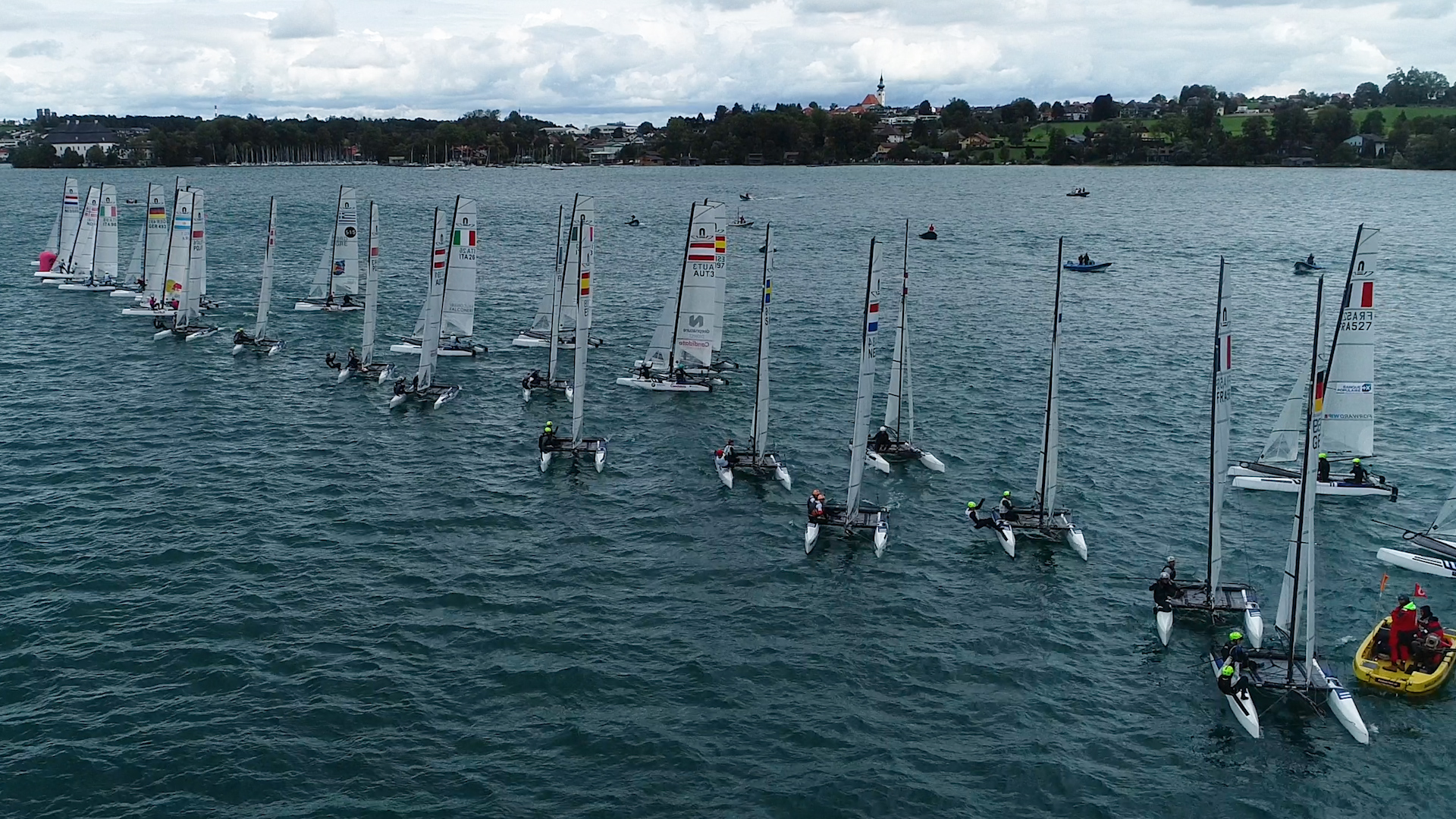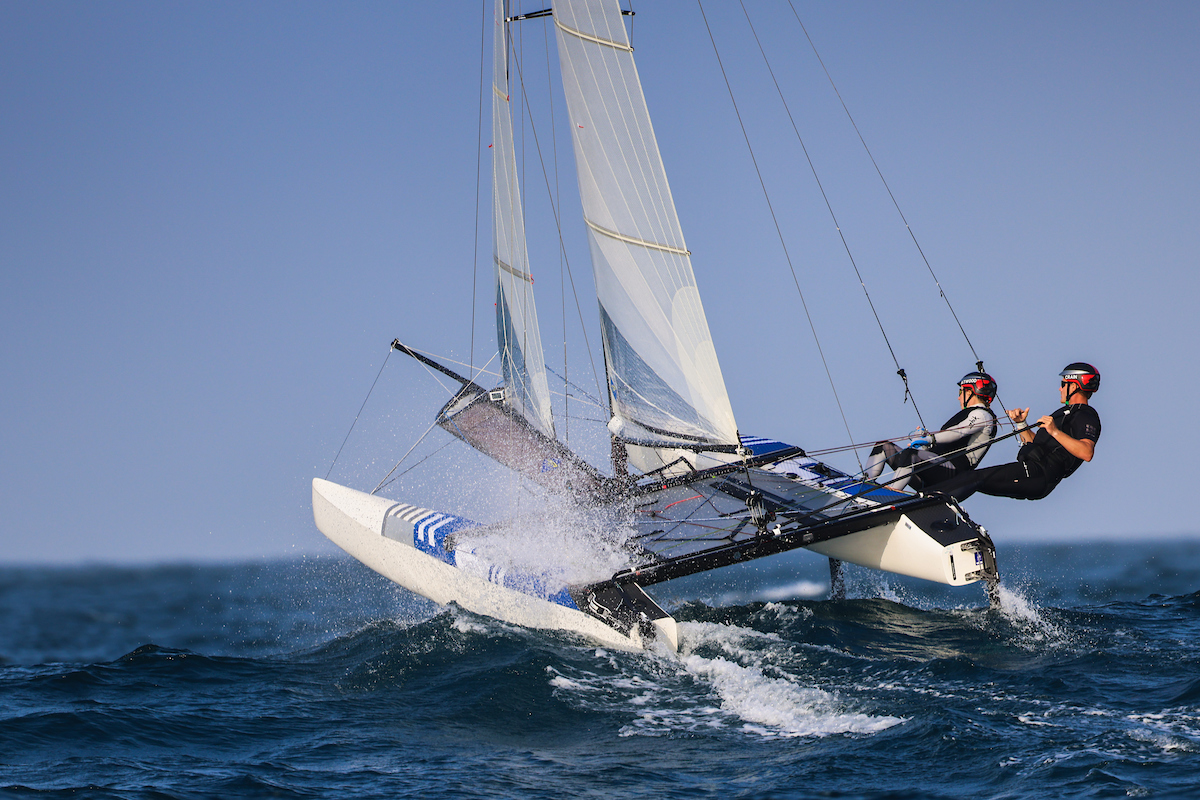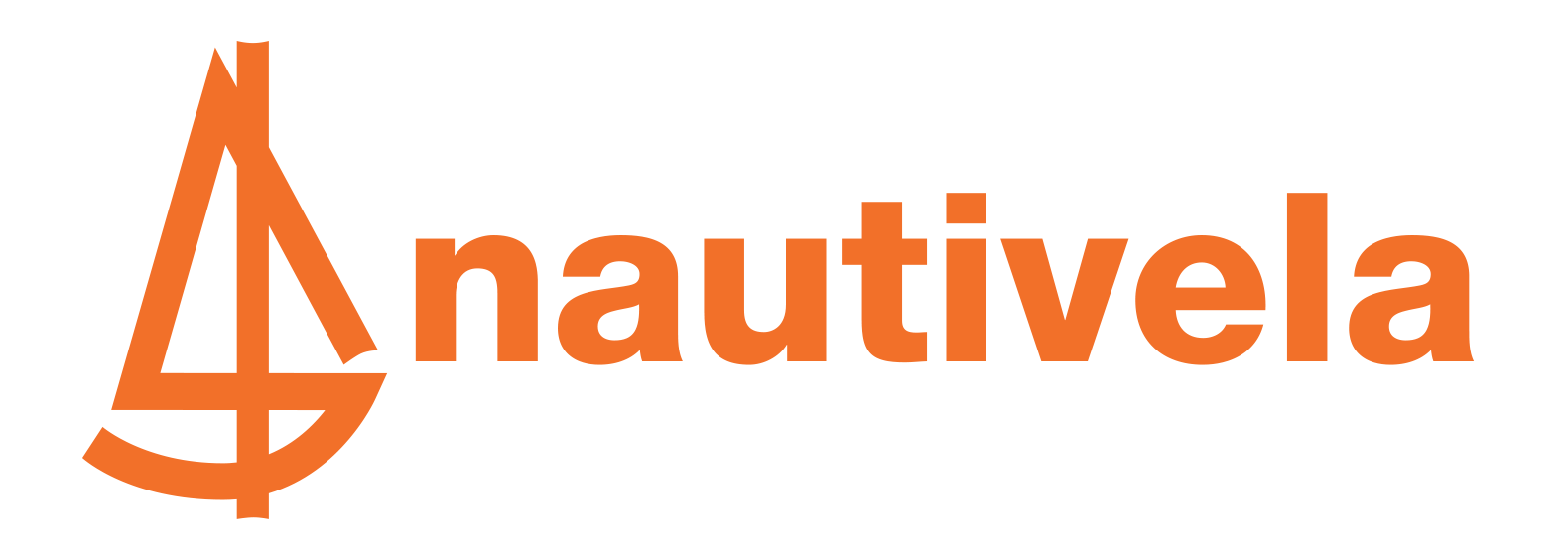Nacra 17 Platform Setup Guide
Nacra 17 Platform Setup Guide
Nacra 17 Tuning Guide
Sections
- Fixed Sailing Setting
- Dynamic Sailing Techniques
- Equipment setup and selection
Fixed Sailing Settings
The sailing settings are divided into 4 wind ranges, as in each wind range the targets, techniques, and therefore tuning are different. The four descriptions are:
- Both hulls in the water (0-6 knots) – drag reduction
- One hull flying (6-8 knots) – marginal and popping – power generation
- Foiling (10-16 knots) – target boat speeds for foiling – power management
- Use a speedometer, don’ try to foil in under 10.8 knots of boatspeed as it won’t work. Once foiling, can foil down to 10 knots but not takeoff below 10.8.
- Overpowered (16+) – lift and drag management
a) The Rake is set using the forestay length, and then tension is set by adjusting the shrouds
b) Base rake is set by having crew on trapeze too leeward, 30 lbs on loose gauge shrouds, the measuring the difference in length between the distance to the bow and the stern (check both sides). This is how the two lighter air settings are measured. However, when setting up for the higher wind settings, stop using the tension gauge and just add 8 mm to the shroud adjusters (or 10 mm for the high wind setting)
c) 2 Hulls in water, set shroud tension to 25. As soon as you can start popping a hull, move to 27 lbs, once foiling, set it to 35 lbs.
d) Diamonds and cunningham working in tandem to balance power. Cunno moves draft forward, so an over reliance on cunno could be slow and lack point as draft too far forward. Using too much diamonds could lack ability to adjust to less pressure in a race. Too little of both and then mainsheet needs to be too far out.
e) The diamond settings is critical to performance. Set up the diamonds to base, but then have a fixed measurement sticker on the mast so you can keep track of your settings on the water as you add tension through the wind range.
f) With diamonds, the first few mm of additional tension stiffens up the mast, and then there is a sharp change in required settings once you move to foiling because that’s when you add Cunningham, and you need enough diamond tension otherwise the mast rotation will move to the middle. The amount of change (10mm to 20mm) needed depends on the mast and mainsail shape, the amount of variability in the wind. Adding diamond tension flattens the mast through the middle of the sail, while the Cunningham falttens and moves the draft forward, so they both must be added in tendem to get a good setup of the sail and ensure the boat is driving forwad.
g) For spreaders, the distance is a line between the spreaders to the trailing edge of the mast. This is set at the base setting (doesn’t matter too much). You can use less spreader rake if you have a soft mast or are a heavy team.
h) General note – a coach can monitors straightness of mast from outside the boat. If things aren’t feeling right, have coach check mast straightness of the mast relative to other boats. If things aren’t feeling right, check this first as things can get out of true and then nothing works quite right.
Foils Notes
a) The downwind rudder angles is a balance of stability. With more lift in the rudders, the sailors have less ability to adjust the pitch with their body weight, and with less lift in the rudders the sailors have more ability to adjust the pitch with their body weight. The amount of lift assigned to the rudders should be adjusted to suit the sailing style and wave conditions so that the team can adequately trim the pitch without the boat becoming too sensitive to movement.
b) Teams must pay attention to have level the boat is sailing. Bow down will require move daggerboard angle than the chart above and bow up will require less, as the overall angle of attack is a combination of the two angles.
c) In general, the more bow down a team is the harder it is to sail with waves, and a crew will have less time to adjust. In flat water, more bow down can be used, but stability, waves, and ability to adjust limits that, especially downwind.
d) To move from marginal to foiling, it is difficult. Teams must get to 10.8 knots of boatspeed, but also must adjust a lot of settings to make the transition. One of the settings that can be adjusted a bit early is the leeward daggerboard being moved to 4 degrees, as it doesn’t add much drag but is one fewer setting to adjust in the moment of trying to get foiling. Teams must know the order and assignments of who will do which settings changes. This is one of the critical things to practice, moving up to 11 knots boatspeed, adjusting all settings as popping and staying foiling. New teams can practice this a lot.
e) For upwind foiling, the rudders move to max differential, but the daggerboards can also have differential. Differential can be added efficiently if the sailing conditions and overall set up are balanced, so teams can look to slightly optimize via daggerboards differential. However, if there is instability due to waves, wind or general sub-optimal set up differential can cause additional headaches that are not worth it. This is especially true if you are unstable with regard t heel.
f) Elevator settings? In light winds, both rudders are at about 2 degrees to minimize drag. Then the moment you try foiling upwind, the leeward rudder moves to max lift and the windward to zero.
Jib
Jib Notes
a) The first thing to fix the jib halyard. This is not a super critical point, but everything must be fixed for reproducing set-ups so it’s included.
a. The first option is to set it for the light so that at max Cunningham it is just bottoming out.
b. An advanced development is to use a lower halyard attachment point in medium wind to separate the main and jib marginally, when compared to very light wind, but this hardly makes a difference and should only be added after teams work on all the other more important stuff.
b) In very light winds some fullness may need to be removed from sails to get flow attachment
Mainsail
Mainsail Notes
a) Batten tension compliments batten stiffness. To depower, loosen battens to the point they can wiggle. To power up, can go quite type, until battens go out of alignment vertically. Each battened can be tuned as such to conditions and stiffness. This is quite an important setting, so teams need to practice setting tension and describing how to replicate their settings. For sure if teams are struggling with righting moment (heal) loosening the battens can be a big help.
b) Outhaul – you can pretty much just fix it in spot and forget it, or you can mess around by eye a bit if you want.
c) Max cunno is found from a variety of ways, from risking breakage, inverting the sail, pulling draft too far forward, and fixed measures on the mast. Sails will shrink if unused over time, and adjustments to the fixed range have to be made as such, but teams should spend effort figuring out a safe max.
a. Every mast you have should have a clear and consistent gauge so you can easily find your max and stick to it. It will be slightly different for each sail, 1-2 cm between a new and old mainsail.
Dynamic Sailing Strategies and Options
Platform Setup
Hulls and Cross Beams
Buying a new or used boat for Nacra 17 racing is a critical first step to getting racing. Pretty much any new generation (2017 onwards) Nacra 17 has the potential to race very competitively to an elite level. Teams at the 2024 Olympics used boats ranging from 2018 to 2024 and did very well with them. Of course, not every boat is perfect, but nothing in the design or building spec has changed in that time and the boats seems to last a very long time, and are extremely durable, especially compared to other Olympic classes.
When setting up a platform, the first thing to do is get it square. Hulls parallel, hulls must be vertical, and the waterlines level. Use a transparent hose with a water bubble ensuring there are no air bubbles in line. At stern use sharp corner between the stern and the canoe body. At the bow, use a point at the middle of the round of the bow (by eye, it’s ok to miss by a couple mm over that distance). Go stern to bow, bow to bow, stern to stern, and cross ways (kitty corner) as well to ensure the whole boat is square and true. Parallel hulls and vertical hulls is the goal. Using packing in the beams to make your adjustments.
Part of the tuning is figuring out whether you want to include front beam pre-bend or not within your overall set up. Top teams use different approaches, but be sure which you are using when you set up to better get ahead of further tuning you might do. One option is to use about half of the pre-bend you intend to use, something like 5mm pre-bend. Which ever pre-bend you choose, the main thing is to get your boat level and square before starting everything else.
Rudders and Elevators
Setting up the rudders/elevators is a critical piece of the puzzle. Note, the transoms of the boat are not perfectly square or perfectly consistent. Teams must establish a plane by which to measure everything against. You are looking for 90 degrees to the square of the boat. Use an angle measurement device:
-Which apps
– Which measurement devices
Find a location on each transom that ends up being 90 degrees. Mark that point with an outline like in six sigma, so you know exactly where to put your measurement tool every time. Do this for each transom. Even 0.2 of a degree in this plane matters, so be precise. For example, a flat water non-windy set up might have the farthest aft elevator position at negative 0.3 degrees, while that will not be sufficient in a wavey and windy venue, where negative 0.5 degrees should be the base set up. That is the level of precision required to get sailing properly.
The next piece of setting up the rudders/elevators is to have a device to make a consistent square to the elevator.
Here is a 3d file for anyone to print.
Ensure this device fits perfectly, as even a tiny variation in how this sits consistently will lead to varying results and imperfect set up.
Now find the perfect balance of the rudder and angle to the elevator.
We will simultaneously fix two critical elements of tuning. Angle of the rudders fore/aft and subsequent angles of the elevator to the boat. The elevators are fixed to the rudders and teams can manipulate the angle the elevator is fixed to the rudder and also adjust the fit within the rudder and the rudder box.
If you have too much aft rake then steering at speed is very hard. If the rudder is too vertical, then the boat becomes very twitchy during gybes. Ultimately, a good starting point for the elevator angle of attack is 3.6 degrees to negative 0.4 degrees.
Set the rudder box.
You can use tape within the rudder box to ensure the rudder is grabbed perfectly every time in the correct position. Use proteck tape or similar on the front top rudder box bearing. On land you can use a strong light to see if there are gaps in your tape to ensure you have a lot of gripping surface along the whole length of the rudder box.
The plastic bearing in the back of the rudder box also must fit your rudder set up perfectly to ensure the rudder remains in the same position. This will require ongoing maintenance. If it wears out, your angles will change.
Set the elevator to the rudder
The elevators screw into the rudders, but they really should be glued using epoxy to ensure they don’t get pulled off. Use a mclube or wax or another substance that blocks the epoxy, so that you can unbond the join between the rudder and the elevator, which you will need to do. Set your boat up with the 3.6 degree to negative 0.4 degree angle, and then see how twitchy it is during gybes. You will need to using trial and error to find the correct combined angle of the rudders/elevator to get your boat working how you want it. Have a system to fix and check the elevator angle so you can make small adjustments precisely and make improvements to your set up, not guesses.
Daggerboards
The element 6 daggerboards (post 2021) are made from different tooling than the DNA daggerboards (2017-2020). They are both the same design, but the end result of the different tooling methodology and execution means the two groups of daggerboards are not exactly the same geometry as each other. Both work for Nacra 17 racing, and both were used at the 2024 Olympics, but the DNA boards are not as consistent and more and more teams are racing on the element 6 boards at the time of writing.
Rudders Elevators
Teams should pay attention to the rudders, aiming to get a set that ‘track straight’. It is possible that some rudder will slowly drift one direction or other, and the sign of a good set is that they don’t do that. Top teams use both DNA and Element 6 rudders.
Elevators are machined and come out very consistently from the factory. The do seam to wear over time, and teams do tend to replace them over a season. The class rules do not allow them to be refinished (currently) for fear of manipulation, so teams should check for smoothness of their elevators
Platform Geometry Double Check
At the 2022 and 2023 World Championship, all the boats competing were measured thoroughly with special attention paid to the platform geometry. Reviewing the data it became obvious that there is a very small amount of variation within the fleet, especially with the top sailors.
As such, we have decided to publish the average measurement data of the critical platform geometries so teams can check their own boats and know they are close to what everyone else is using. You should assume that all the top sailors were racing with their platforms very close to this geometry at the 2022 Worlds.
The 2023 geometry confirmed the 2022 geometry measured, and the main reasons behind publishing the average numbers remains the same. All teams should know that boats setting at these numbers can be world elite competitive, as demonstrated by the boats doing so at these geometries.
These measures were taken with the platform in racing trim, so with beam bend on but without rig tension.
Here are some average measurements of the platforms.
Bow to Bow – Average 2178 mm (2022) – 2177 (2023)
Measure across front of hulls from the centre line of the bow of the starboard hull to centreline of the bow of the port hull at the chine height.
Transom to Transom – Average 2191 mm (2022) – 2193 (2023)
Measure from inner edge on port hull to outer edge of the starboard hull, measured across the line formed by the underside of the top transom gudgeon fitting.
Toe In Toe Out – 10mm (2022 and 2023)
Support the boat on trestles and place the boards fully down and set at the zero rake point. Measure across the bottom of the hulls between the centre line of the two boards and at the exit point of the board from the bearing. Take one measurement between the leading edges and one measurement between the trailing edges. The difference between the two numbers gives you the toe in and toe out measurement.
Lower Bearing to Lower Bearing (aft) – 2264 mm (2022) –
Measure across the platform, underneath the hulls, from the inside edge of the port bearing at the bolt point to the inside edge of the starboard bearing at the front bolt points. Measurements taken at the aft bolt point are within +/- 1mm of the front measurement.
Daggerboard tip to daggerboard tip – 860mm (with slight inward tension) (2022) – 857 (2023)
Support the boat on trestles and place the boards fully down and set at the zero rake point. Measure between the tips of the boards with light pressure pushing the tips together to take out any slack.
Rudder Rake adjustment range – 4 degrees (4.05 degrees max) – a note about this. There were a few teams that has range of motion below 4 degrees. It is likely this is caused by over-tension of the spring, which improves ‘pull’ of the system, but limits performance. Teams should pay attention to ensuring they have the full range of motion in their rudder rake adjustment system.
Daggerboards
At the 2023 Worlds, there was also the addition of foil scanning to our measurement procedures, whichl will occur at most future regattas and at the factory for new foils. Here is an initial report from World Sailing on the topic.
The main conclusion from this report is that the Element 6 built daggerboards are much more consistently built thank the DNA ones were. Almost all measures taken of the E6 boards were in a very small range from each other. This bodes well for the long-term future for the class and its ability to provide consistent equipment for all sailors.
The DNA boards erred to the thick side in some areas and the thin side in other areas, and were generally less consistent too.
From a competitive standpoint, 13 of the 20 foils used by top 10 competitors at the 2023 World Championship were Element 6, including all 6 boards used by the medalists. So not only is the consistency of the E6 boards excellent, but they are also world class in speed, if not the fastest available. While good results are possible on the DNA boards, as demonstrated by there being competitive finishes using the older equipment, teams who are improving in their skill profile should migrate toward the E6 boards knowing it is the right solution for sailing well now and for the class tightening up our measurement requirements.
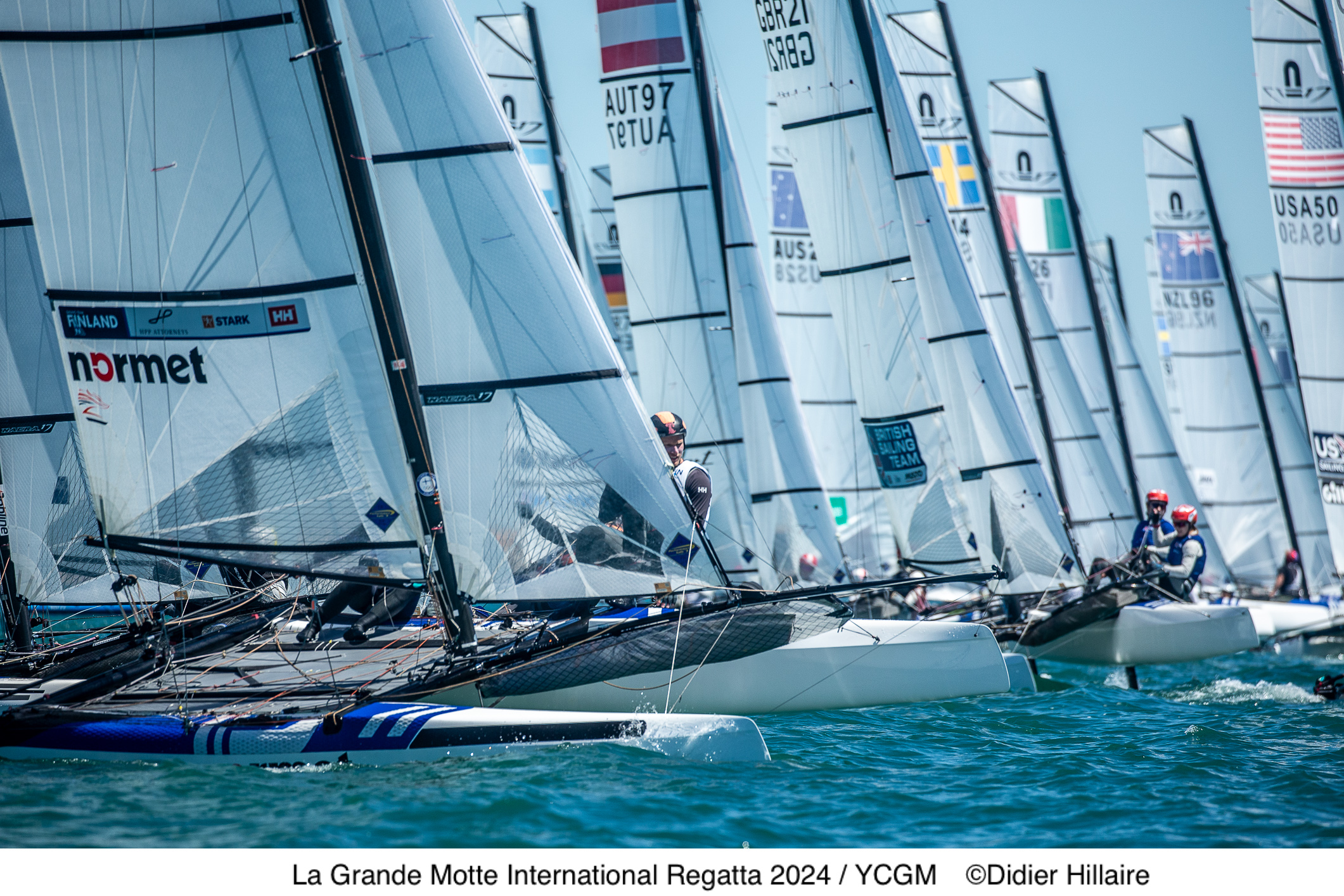
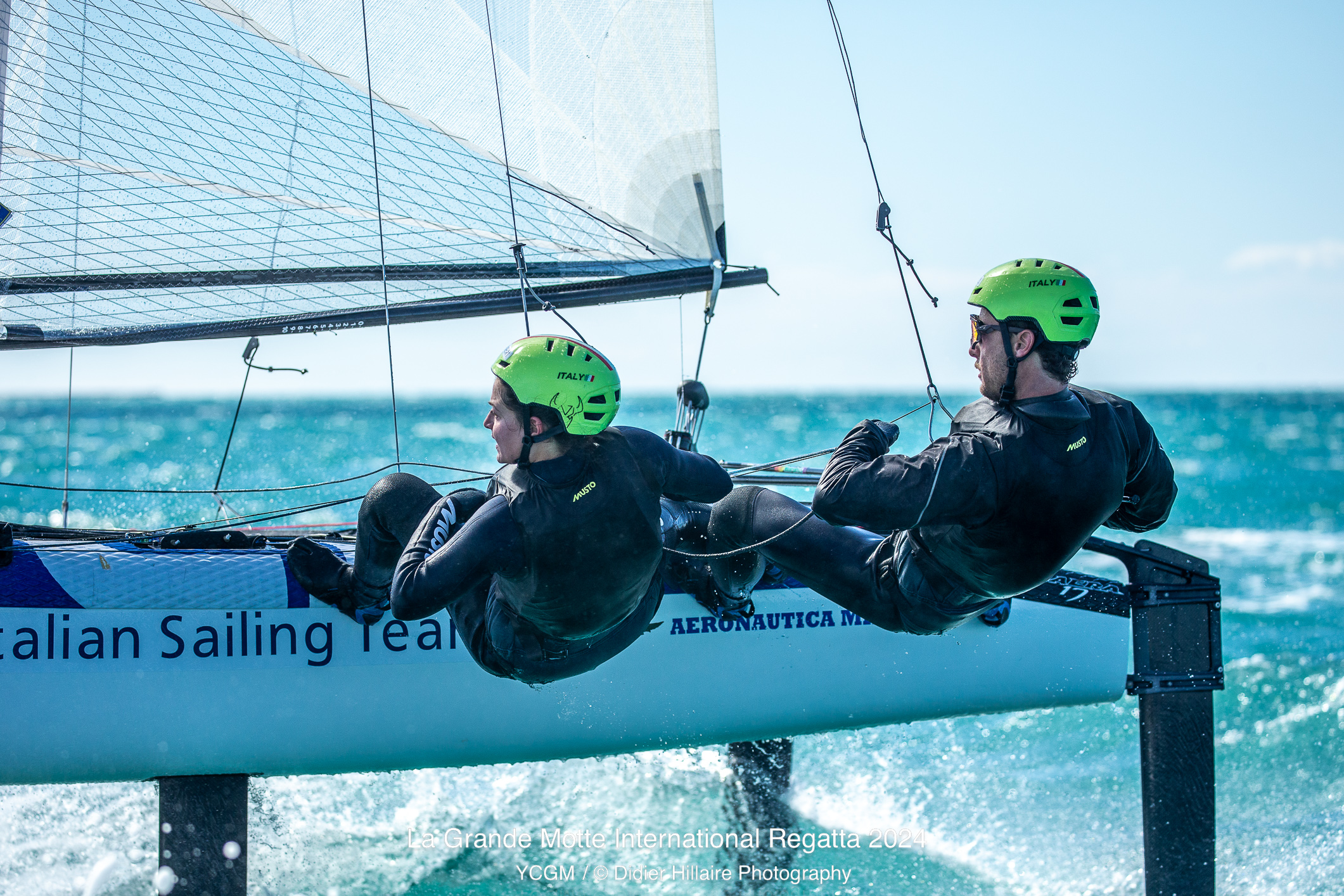
Join the Elite Community of nacra17 Sailors and Fans
We are passionate about sailing and the nacra17 class, and we are committed to promoting and growing the sport of sailing around the world. Join us today and be a part of the nacra17 sailing community!.
OUR NEWS
Stay Up-to-Date on the Latest News from nacra17
Young Swedes show Top Guns the way around Attersee
Emil Järudd and Cecilia Jonsson (SWE) showed the world-class Nacra 17 fleet the way round a very tricky Lake Attersee race course on day one of the 2020 Forward WIP European…
Young Italians riding high in the waves
Gianluigi Ugolini and Maria Giubelei of Italy closed in on the Nacra 17 podium after the Italian team posted the best scores of the day, the young crew negotiating the…
Young Italians float out to a bigger lead
Gianluigi Ugolini and Maria Giubilei wove a masterful path through the minefield of a difficult race course to extend their lead in the Nacra 17 fleet on day three of…

